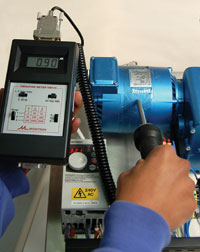
Posted to News on 22nd Nov 2010, 00:00
Feeling alright?
Changes in a machine's vibration signature tend to provide one of the earliest indications that something is wearing or is likely to fail. Andy Anthony, Operations Director with Monitran, provides an introduction to vibration sensors.

As we all know, times are still difficult; and for those involved in manufacturing and processing, surviving (let alone prospering) often requires maintaining existing machinery and equipment in favour of spending out on new. Essential to the well-being of the machinery and equipment is of course the health of their respective drives, motors, gears, pumps, fans and so on. Thankfully, monitoring the condition of these components, either on a regular or continuous basis, allows for the detection of the early signs of failure.
Moreover, data captured can feed into a condition-based predictive maintenance (CBPM) strategy; a practical, cost-effective alternative to both failure-based maintenance and conducting maintenance on a periodic basis irrespective of machine use.
As for which conditions to monitor, temperature and power consumption are obvious contenders, but both have drawbacks. Some faults can manifest themselves without a change in temperature, and monitoring power consumption may not tell you where the fault is. For example, a motor may start drawing more power because a gearbox, drive shaft or other mechanical component down line is failing, while the motor itself is mechanically sound. Accordingly, it is now widely accepted within the engineering community that vibration - or rather changes in a machine's vibration signature - provides one of the earliest indications that something is wearing or is likely to fail in some way. Moreover, analysis of the vibration signature can provide much intelligence regarding the nature of the fault that is developing.
Protection and analysis
At the risk of taking you back to your school-day physics, and experiments involving toy cars and tickertape, it is worth recapping on how vibrations are essentially displacements occurring over, typically, short periods of time; and a moving surface/object does so with velocity and that the rate of change of velocity is of course acceleration. More often than not, vibration sensors are called accelerometers, even if their internal circuitry is conditioning velocity and the output voltage is proportional to mm/s.
There are essentially two types of vibration sensor, those with DC outputs and those with AC. The former are best suited to 'machine protection' as they produce an output proportional to velocity or acceleration, in the range 4-20mA, and so are ideal for interfacing with PLCs or similar monitoring/shut-down circuitry. Most general purpose sensors will have a frequency response of about 2Hz to 1kHz. Various sensitivity ranges will be available and you should select one that makes the best use of the 4 to 20mA output. For example, 0 to 20mm/s is common for a velocity sensor and 0 to 10g (RMS) is typical for an accelerometer.
To identify the optimum sensitivity range you need to determine what the normal levels of vibration are and decide at what levels alarms should be raised and/or machinery shut down. However, you will probably need to factor in machinery start-up vibrations; which may temporarily exceed your alarm and even (presumably higher) automatic shutdown levels. You can do this in your PLC or custom control circuitry, but it's worth noting that there are now some very clever vibration switch modules on the market that have dual outputs (one for an alarm and one to trigger a shutdown) and which can ignore the first few seconds worth of vibrations (ie start-up).
As for sensors with AC outputs, they are best suited to analysis, as the output (which tends to be proportional to acceleration rather than velocity) can be fed into an FFT analyser to yield information on the amplitude and structure of the vibration. Compared to DC output sensors, these tend to have a slightly wider frequency response (0.8kHz to 12kHz) and operate between ±80g. They will require a constant current source, of just a few milliamps, and might be able to output between ±8V.
Different sensitivities will be available, so again it is a case of deciding how best to make use of the sensor's output. If levels of ±80g will be experienced then, a sensitivity of 100mV/g will give you a full output swing. But if ±8g is the maximum the sensor will ever be exposed to, why stick with 100mV/g? You'd only see a voltage swing of ±0.8V. At 1V/g sensitivity though, the ±8g is represented across the full ±8V range.
Importantly, vibration sensors need to be fit-for-purpose, as they could be protecting equipment worth several thousands of pounds. Thankfully, the majority of general purpose vibration sensors will suffice for many seemingly 'novel' applications; it just requires a sensible approach to sensor selection. In addition to selecting the optimum sensitivity, give thought to operating temperature ranges, sealing and hazardous environments. There are also a host of mounting and wiring considerations.
As for what constitutes a 'special purpose' sensor, this might be one capable of operating at up to a few hundred degrees Centigrade, or provide higher sensitivity than normal. Other 'specials' include charge output accelerometers, dual output devices for combined analysis and monitoring, devices which measure acceleration and temperature, tri-axial sensors and seismic accelerometers.
And when standard and even special purpose sensors don't seem to quite fit the bill, it is worth remembering that a number of sensor OEMs offer a full custom design service. Indeed, truth be known, it is through developing custom sensors that off-the-shelf special purpose ones came into being.






